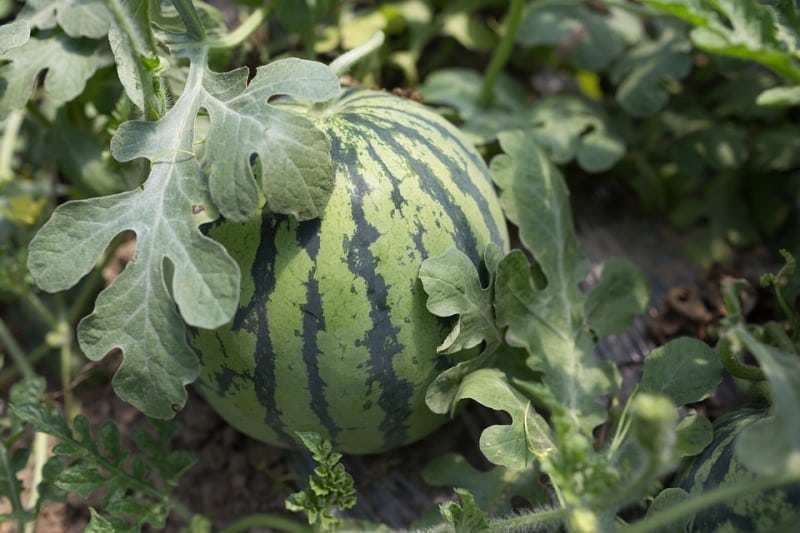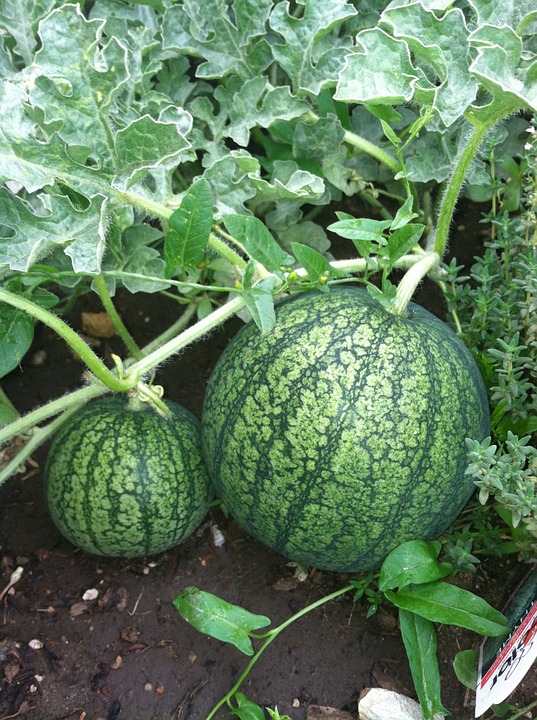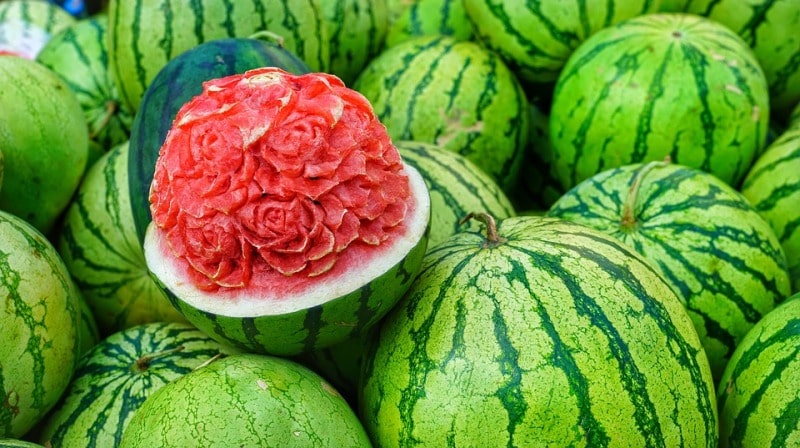Watermelon profits, farming information and growth stages
Today, we discuss the topic of growth stages of watermelon, watermelon profits and yield. Watermelon (Citrullus lanatus) is a fruit, belongs to family Cucurbitaceae is a flowering plant originally from South Africa. It is a fruit, which is a special type referred by botanists as a pepo, a berry that has a thick rind and flesh mesocarp and endocarp.
Watermelon fruit contains about 6% sugar and 92% water by weight. As with many other fruits, Watermelon is a source of vitamin C. Watermelon rinds, generally a light green or pale green color, are also edible and have many hidden nutrients, but most people avoid eating them due to their unappealing flavor. Watermelons are sometimes used as a vegetable.
Watermelon fruit of standard size grows into long, rambling vines. There are smaller, hybrid vines, which spread to a diameter of 5 or 6 feet. Watermelon vines are clothed with large leaves and light yellow color flowers, which are followed by the juicy fruit.

Some facts about Watermelon farming:
- The watermelon is a flowering plant that originated in northeast Africa, where it is originate growing wild. Citrullus colocynthis has sometimes been considered to be a wild ancestor of the watermelon; its native range extends from North Africa and West Africa to west India.
- Botanically, watermelon is known Citrullus lanatus and it belongs to Cucurbitaceae family.
- Watermelons need a long growing season with a hot summer, humid atmosphere and a lot of space. These melons are very easy to grow when planting in fertile, well-drained soil with full sun.
- Watermelons grow in sandy loam soil that drains easily. It grows well in black soil and sandy soil. However, they should have a good amount of organic content and must not withhold water. Water must easily drain off from the soil else the vines are probable to develop fungal infections.
- According to the Food and Agriculture Organization of the United Nations (FAO), China is the top producer, with 75 million produced in 2014.
- Watermelons require a long growing season (at least 80 days) and warm ground for seeds to germinate and grow. The soil must be 70 degrees F or warmer at planting time.
- Watermelon bed in a sunny location with well-drained, loose, rich soil that has a pH level between 6.0 and 7.5. Acidic soil could result in withering away of the seeds. While soil with a neutral pH is preferred, it can grow well even if the soil is slightly alkaline.
- Give watermelons at least six to eight feet of space between plants because planting them too close discourages the growth of large melons and encourages vegetation growth. For growing watermelons, the best temperatures are between 70 and 90 degrees Fahrenheit, but above this temperature range, the plants can drop their flowers and bland melons effect from consistent temperatures below 50 degrees Fahrenheit during the growing period.
- The time it takes for a watermelon to mature could be anywhere from 65 to 90 days after planting. Once the fruit sets to tiny marble-sized melons, it takes up to 45 days for those tiny melons to develop into watermelons 10 pounds in size or more.
- Watermelon is a dry season crop and it should be planted with irrigation. The watermelon beds are irrigated 2 days prior to sowing and then again 5 days after sowing the seeds. As the plant grows, irrigation is finished on a weekly basis. Attention should be paid to water stress at the time of irrigation since it can lead to fruit cracking. While irrigating, water should be restricted to the root zone of the plant.
- The watermelon sowing time is mid-January to March month and under protection in November to December.
- In India, since the climate is mostly tropical, all seasons are appropriate for watermelon cultivation. However, watermelon is sensitive to cold and frost. Hence, in parts of the country where winter is severe, watermelons are cultivated after the frost has passed. In places like Tamil Nadu, Maharashtra, Andhra Pradesh, and etc. watermelon cultivation is feasible almost any time of the year.
Read: Okra Farming Cost and Profits per Acre.
Growing stages of Watermelon plant
Seedling: The first stage is also called germination of watermelon growth occurs when seeds are placed in the soil. When soil temperatures exceed 65 degrees Fahrenheit, bury the seed depth of 4 times its width. Once planted and then watered, the seed sends out a stem, or hypocotyl, and root, or radicle. In 3 to 12 days, the hypocotyl pushes the first two leaves, or embryonic leaves, above the surface of the soil.
Vining: 5 to 10 days after germination, the first set of true leaves emerge from the stem. These leaves are capable of photosynthesis, which is the system plants use sunlight to convert carbon dioxide and water to food. A vine of about one foot long grows out and large lobed leaves begin to form. This runner will continue to develop until it reaches about 12 feet in length. About one month after a watermelon plant sends out its first vine, several more vines will start to grow. Leaves form on all the vines and start to grow larger. At this time, top dress plants with 1/2 cup bone meal and gently works it into the soil, being careful not to damage shallow roots. Present watermelon seedlings with one to two inches of water per week.

Growth: Watermelon is a space hog; vines can attain 20 feet in length. Thus plant where there is plenty of open ground. Add a balanced fertilizer that is very high in nitrogen. Sow 8 to 10 watermelon seeds in a hill, and push seeds one inch into the soil. Space hills 3 to 4 feet apart, with at least eight feet between rows. Thin plants to the three best in each hill. Maintain soil free of weeds by shallow hoeing or with a layer of mulch.
Watermelon plants have moderately deep roots and watering is seldom essential unless the weather turns dry for a prolonged period. When vines initiate to ramble, side dress plants with half a cup of balanced fertilizer (5-10-5). The third application of fertilizer must be made when melons are set. Withhold water as melons create to mature to intensify sweetness.
Flowering: About 2 weeks after a plant sends out most of its runners, watermelon produces male and female flowers. The male watermelon flowers develop first. They give pollen, but do not produce fruit. The watermelon female flowers form shortly after the male flowers. Watermelon flowers last for one day so there must be an adequate number of bees and other pollinators in the area when the flowers are viable.
Fruiting: Once pollinated, the miniature fruits swell up to form speedily growing watermelons. They are considered viable after they attain the size of a golf ball. This generally takes a day or two. Watermelons will continue to develop for 30 to 35 days as long as they remain undisturbed.
Fruits may be harvested 80 to 100 days after planting. Harvest the fruit when fully mature because once picked they stop ripening and will not develop in any way. Fruits are ripe when the tendrils at the point where the fruit stalk is attached to the major stem become dry and when the color of the rind in contact with mulch turn from green to yellow. Pick fruits with the watermelon fruit stalk attached using a sharp knife. The cut surface of the stalk can be treated with Bordeaux paste.
Depending on the watermelon variety, the fruit takes up to 1 month to fully mature. It can be difficult to know when the melons are fully ripe, particularly at the beginning of the season. Some signs are the tendrils on the vine varying from green to brown, the spot on the ground where the melon laid changes from white to yellow and the sound made when thumping the watermelon changes to a hollow sound.
Read: Garlic Cultivation Project Report.
The yield of Watermelon and profits of Watermelon:

The average yield of 25-30 tonnes/hectare (4.5kg – 11kg/fruit) can be obtained depending on watermelon variety and adherence to good agricultural practices.
When it comes to watermelon profits, it is very much profitable crop due to growing demand and income per acre. A watermelon farmer gets a profit of 2 lakhs to 3 lakhs per acre in India in 2 to 3 months period. However, Japanese watermelon gives good profits for farmers.
In western countries, The yield of watermelon is about 10,000 to 75,000lbs/acre and expected profits are $1000 to $25,000 per acre.
Read: Growing Tomatoes from Seeds.
U r doinga great job for farmers joing from it field
i love your article thanks for much help
Not yet
need more of this content you are very helpful toward small gardeners
I love your article too…so informative
Good job friend
Good job
Very good information.good job…..